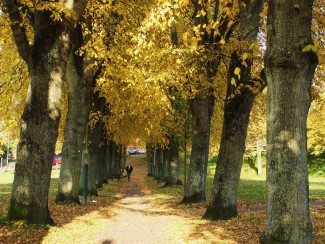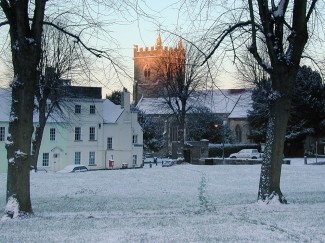The Greencroft: a brief history
Introduction
The Greencroft is the “green lung” of the Milford Street bridge project area. It provides grassy recreation space, a play area for younger children, and has many magnificent trees which were planted in the 1890’s, including an avenue (pictured). Currently the Greencroft is bordered on 3 sides by the Ring Road, Bourne Hill and Greencroft Street, but it used to cover a much larger area. Many local people can recall the times before the Ring Road cut a swathe through the Greencroft, but this lovely area has a much longer history, some of it quite dark.
A Brief History of the Greencroft
Dating from very early times, archaeology in this area has thrown up some interesting items, such as a Paleolithic axe, and some Saxon burials. There is an unvalidated theory that the Greencroft area may have been the site of a Saxon battle in AD 552.
The Middle Ages
However, the Greencroft itself is certainly documented as a piece of common land from the early days of the new City of Salisbury in the late 13th century, and throughout the Middle Ages. Although it was farmed, rights were reserved by the city for playing and walking.
The wool trade was an important part of the Wiltshire economy during Medieval times, and in Salisbury the Greencroft had a role both in the husbandry of sheep and the production of cloth. From 1570 the Michaelmas fair, for the sale of sheep, was held each October on the Greencroft, the profits going to the city. This continued for 2 centuries until the Wilton Corporation seemed to take objection to the practice, presumably wanting the fair on its own land, as the right to hold 2 sheep fairs a year was subsequently leased by the Greencroft to the corporation. Sheep being herded to the fair were still grazed overnight on the Greencroft even within living memory. Hear Phyllis Maple’s account of this practice here.
Wool cloth preparation supported many trades as it had to be washed, carded, spun, woven, fulled and dyed. Teasels for the fulling were supplied in abundance from local gardens, and the Greencroft itself was used as a tenter ground where cloth was stretched on racks before being bailed (hence the term “on tenterhooks”).
The 16th to 19th centuries
The city bought the freehold of the Greencroft in the mid-16th after which it was often used for executions and for the burial of plague victims. A particularly ferocious visitation of the plague occurred in 1627 in Salisbury, with many deaths. The poor were buried in plague pits on the Greencroft, thus saving it from later development as the land cannot be built upon.
In the 17th century a brewer leased the “herbage” of the Greencroft, and it is interesting to note that whenever the grass is allowed to grow long, barley (used in brewing) is among the plants that show themselves.
The Corn Laws of the early 19th century, in keeping the price of grain high, caused hunger and unrest among poor people throughout the whole country. In 1830 a mob approached Salisbury from the London Road, in violent protest at the law. The protesters were met on the Greencroft by the magistrate and a posse of special constables, and the Riot Act was read to the throng. The Wiltshire Yeomanry then charged the agricultural workers, with many arrested and gaoled. As a result of the riots throughout Wiltshire, 150 from the county were sentenced to transportation.
In the 19th century there was a concerted effort to clean up the towns of Britain, including Salisbury, as many suffered from poor drainage which led to unsanitary conditions and disease. Various types of drainage systems were trialled, including a manually operated pump on Greencroft Street. This failed … one can only imagine the consequences!
In the late 19th century the magnificent trees were planted that can still be seen on the Greencroft today. The date of the planting is not clear; possibly it was to mark Queen Victoria’s Diamond Jubilee in 1897.
With thanks to Eve Shillingford, whose paper “The Greencroft” supplied much of the information in the above section.
Read more about The Greencroft in our Memory Walk.
Click here for “The Twentieth Century: residents’ memories of the Greencroft”.








Comments about this page
Fascinating history – really brings the past to life. I wonder if an rioter-antecedents from Australia will see this!
Add a comment about this page